2018 Audi Q7 3.0 TFSI Quattro Prestige
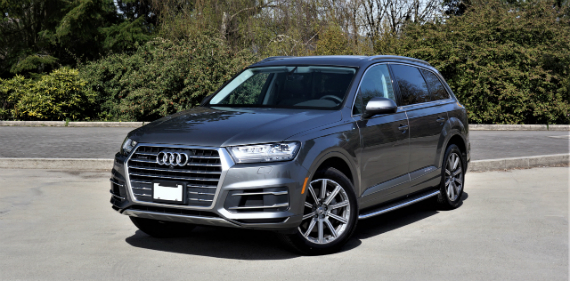
Where is the world’s best mid-size luxury SUV made? Audi can make a good argument for Bratislava, Slovakia, where its recently redesigned Q7 SUV flagship has been assembled since inception in November of 2005, when the 2006 first-generation model arrived on the scene and almost immediately became the darling of the seven-passenger luxury crossover SUV market.
Astute readers will correct me by stating the Q7 is also produced in Kaluga, Russia and Aurangabad, India, but the one we get hails from the quaint Slovakian capital that flanks the Danube River, its fertile banks surrounded in vineyards, the entire area nestled within the Little Carpathian mountains, a picturesque part of Europe that rivals its Austrian and Hungarian neighbors for good beer and good times.
This said the only Audi vehicles I’ve ever driven through Europe were on Austrian and German roads, and never once in a Q7. My four-ringed adventure began in the Alps near Salzburg aboard a bevy of TT Coupes, followed up by the premium brand’s A8L flagship sedan powered by a ridiculously potent turbo-diesel V8 on the autobahn between the Red Bull capital (and of course childhood home to Mozart—I walked past Hagenauerhaus on my way to dinner while visiting on a separate occasion with Maserati) and Audi HQ in Ingolstadt. How I would love to drive this new Q7 over the same routes, or for that matter any of the other circuitous European roadways I’ve grown to appreciate from many visits across the Atlantic since youth (back then we had a VW 411 “Squareback”, not exactly in the same league).
The first-generation Q7 aged gracefully, having managed to maintain its popularity despite few updates during its decade-long run, which is a nod to the original SUV’s good inherent design both aesthetically and mechanically. This second-generation version, which arrived in 2016 for the 2017 model year, rides on a new lighter weight chassis architecture that’s allowed for a significant 660-lb reduction in mass, while this in turn has resulted in the first-ever application of a fuel-efficient turbocharged four-cylinder in the large albeit still mid-size three-row SUV.
I drove and reported on the 2.0 TFSI equipped Q7 last year and not only found it wholly adequate, but in fact its 252 horsepower and 273 lb-ft of torque felt downright spirited thanks in part to the standard eight-speed automatic and efficient Quattro all-wheel drive system it comes mated to, but for those that make their German engineering choice with an eye on performance first and foremost, I recommend the V6.
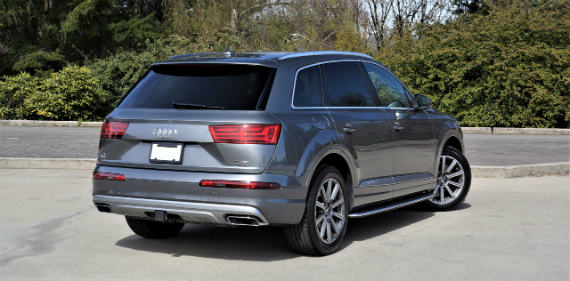
The 2018 Audi Q7 3.0 TFSI Quattro shown on this page felt much the same as a V6-powered model I also tested and reviewed last year, although this variation on the theme didn’t include an upgrade to sportier wheels and tires, Audi offering a number of sharp looking 21-inch rims to satisfy those looking for slightly more bespoke styling and a tad more performance. With its visual focus more about luxury than sport, I still think my Q7 loaner looked suitably planted with its 20-inch 10-spoke Star design alloys.
As you might expect, the 2018 Q7 is mostly carryover from last year, this only being the second-gen model’s second year of availability, so therefore the only change this year is the addition of standard proximity-sensing keyless access to the base Premium model, plus the sensational 3D Surround Sound Bose audio system with 19 speakers and 558 watts of power, Audi side assist blindspot warning, and Audi pre-sense rear advanced driver assistance systems added to mid-range Premium Plus trim, the latter feature using a rear-facing camera to detect and warn of potential rear-end collisions, at which point it mitigates possible injuries by automatically adjusting the seats, tightening the seatbelts, plus closing the windows and sunroof.
While we’re talking trims, the Q7 is once again available in three grades including $49,900 Premium, $53,900 Premium Plus and $65,400 Prestige. Quattro AWD is standard, while the aforementioned 2.0-liter turbo-four is standard in Premium and Premium Plus trims, while not available with Prestige. The 3.0-liter supercharged V6 is a $6,500 option in either base or mid-range trim, with the result of this choice being 333 horsepower and 325 lb-ft of torque for considerably stronger straight-line performance, its zero to 60 mph sprint time improved by 1.4 seconds from 7.1 to 5.7 seconds, plus almost no downside in fuel economy as per the EPA’s official claimed rating of 19 mpg city, 25 highway and 21 combined for both engines.
Yes, I know this seems strange, so I found my second witness above the 49th parallel in Canada, where the metric system Canadians use shows ratings of 18.6 mpg city, 25.0 highway and 21.2 combined for the V6 and 19.3, 24.7 and 21.4 respectively for the I-4 when converted. With a fraction more detail it’s easier to see that the four-cylinder is slightly better on fuel, but the difference is so nominal it’s hardly worth calculating or concerning yourself. Truly, the 2.0 TFSI is more about reducing the Q7’s initial price than ongoing costs.
Additionally, with the optional tow package added to both four- and six-cylinder powered Q7s, the latter increases its trailering capacity by more than 3,300 lbs over the former, from 4,400 lbs to a surprisingly capable 7,700 lbs.
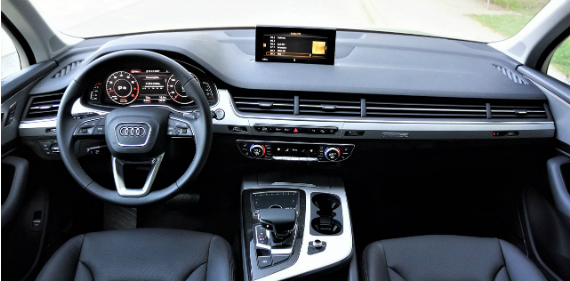
No matter which engine you choose, base Premium trim includes standard self-leveling Xenon plus headlights with washers, LED daytime running lights, LED taillights, alloy wheels (18s with the I-4 and 19s with the V6), heated power-folding side mirrors, stainless steel door sills, proximity-sensing keyless access, virtual pedal proximity-sensing trunk release, pushbutton ignition, a leather-wrapped steering wheel, paddle shifters, an electromechanical parking brake, rain-sensing wipers, Audi Drive Select performance modes, an auto-dimming rearview mirror, a HomeLink garage door opener, a cooled glove box, heatable eight-way powered front seats with four-way powered driver’s lumbar support, driver-side memory for the seat and side mirrors, leather upholstery, genuine oak hardwood, piano black lacquer and real aluminum interior trim, tri-zone automatic climate control, a 7.0-inch infotainment display that powers up from within the dash top, HD and satellite radio, a powered panoramic glass sunroof with an electric sunshade, a powered liftgate, a retractable cargo cover, 50/50-split power-folding third-row seatbacks, front and rear parking sensors, engine stop-start, regenerative braking, and Audi’s pre-sense basic driver assistance system that detects when an emergency maneuver is being made and then initiates all of the crash preventative measures noted earlier about pre-sense rear, plus pre-sense city front collision warning with autonomous braking.
My Prestige tester included all of the above, plus everything from mid-range Premium Plus trim such as its auto-dimming side mirrors, blindspot warning, power-adjustable steering column, 7.0-inch color multi-information display, larger 8.3-inch infotainment display, navigation, 3D Surround Sound Bose audio, stainless steel trunk sill protection, Audi connect assistance and security services, and more.
Lastly, exclusive Prestige features include full LED headlamps for much brighter nighttime drives, a larger set of 20-inch alloys on 285/45 all-season run-flats for better grip, an additional rear zone for the climate control system, the Audi Virtual Cockpit fully digital 12.3-inch TFT gauge cluster, a head-up display projecting key info onto the windscreen ahead of the driver, 360-degree Topview surround parking camera, ventilated and 12-way powered front seats, four-way powered front passenger lumbar, second-row side window sunshades, and more.
Of course, some of the features that come standard with top-line trim can be had in option packages and as standalone upgrades within each trim level, while even my top-line Prestige tester featured a $650 Cold weather package with a heatable steering wheel, heatable rear outboard seats, and all-weather floor mats.
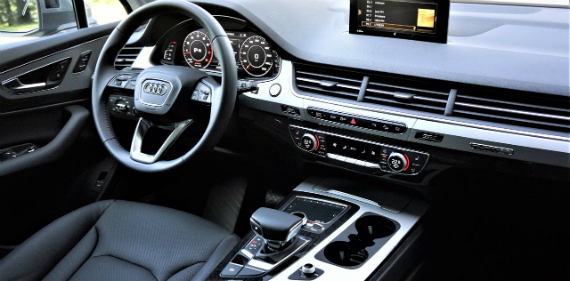
If this were to become my personal ride I’d be tempted to add the $2,400 Driver Assistance package due to its auto high beam assist and adaptive cruise control with stop and go alone, while this suite of advanced safety features also includes Audi pre sense front, active lane assist, traffic sign recognition, and traffic jam assist, a semi-autonomous steering feature that does the driving for you while stuck on well-paved congested roadways at speeds from 0 to 40 mph.
Additionally, the already excellent Bose audio system can be traded in for an even more impressive $5,000 Bang & Olufsen system with tweeters that power up out of the dash and many other advanced audio technologies. There are plenty of other upscale features to finish off your Q7, but I’ll leave these for you to discover.
Naming off options and standard equipment might help put the Q7’s value proposition into a better light, but it hardly relates the experience of actually spending time inside. It remains one of the best interiors in its class thanks to Audi’s pleasing horizontal design mixed with fine attention to detail. The quality of workmanship and materials chosen are difficult to match in this class, and the overall layout, ease of use, and general comfort comes close to perfection.
The Q7 may excel even further above most peers in driving dynamics, by somehow balancing a gentle ride with superb handling. I’m always amazed at how small the Q7 feels when at the wheel, as if it’s outwardly sized a category down from its true three-row mid-size dimensions, but numbers don’t lie and your rear passengers won’t complain about being cramped, although it’s so much fun to drive that backseat drivers may ask you to slow down.
The Q7’s speed-sensing electric power-assist steering feels just right and responds to input quickly and accurately, while the SUV’s fully independent double wishbone front and five-link rear suspension system absorbs all the nasty road imperfections yet still manages to stay glued to the road even when pushed much harder than you might think possible. Audi may have found the ideal compromise between sport and comfort, as I never felt like I was giving up either. Added to this is Quattro AWD for all-season confidence, a system that has saved me from snow covered ski hill parking lots and launched me out of even deeper snow banks plenty of times, and would no doubt be just as capable of dealing with muddy cottage backroads, etcetera.
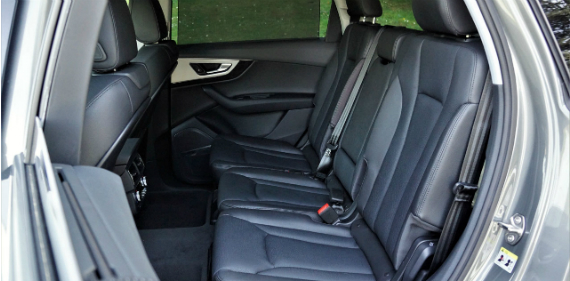
And that from an SUV that can gobble up seven occupants and much of their cargo, the area behind the rearmost seats good for 14.8 cubic feet of what-have-you, which is about as much as a generously sized sedan’s trunk, while if you fold those rear seats flat via the aforementioned power controls you’ll end up with 37.5 cubic feet behind the second row, or go a step further and you’ll have a cavernous 71.6 cubic feet of available space, and more so a completely flat load floor.
Even better, Audi was really inventive with its second row seats, as they’re not split in the usual 60/40 configuration, and not even sectioned into a 40/20/40 division that allows a narrow pass-through down the middle for skis and other long cargo, but they’re almost evenly divided at 35/30/35 for a much larger center pass-through and a more comfortable middle seating position.
Power releases pop the second-row seats forward for easy access to the third row, and while I wouldn’t want to spend an entire day back there I was able to buckle in my five-foot-eight frame without discomfort. This still left plenty of legroom for second-row passengers, which certainly won’t be able to complain about spaciousness in all other directions either, or comfort.
Is the Q7 the best mid-size luxury SUV available today like I inferred at the beginning of this review? My answer would depend on your personal priorities, such as performance over luxuriant pampering, how you prefer controlling infotainment functions, from a simple, straightforward touchscreen or via a rotating knob, touchpad (for pinch, swipe and finger gesture capability) and surrounding buttons on the lower console as Audi provides. The system is excellent and incorporates Apple CarPlay and Android Auto, accurate navigation, superb backup and overhead cameras, plus its depth of color, resolution and overall speed of operation can’t be faulted.

Added to this, the Audi Virtual Cockpit is by far best of the best when it comes to digital gauge clusters. I love how the “VIEW” button on the left steering wheel spoke expands the multi-info display to epic proportions, leaving smaller digital dials for speed and tachometer readings. This allows the navigation mapping and route guidance info to almost completely take over the display, or one of many other functions within the system.
Yes, it’s difficult not to love the Audi Q7, which is why there are so many on American highways and byways. It would be unwise to buy into this category without experiencing a Q7 first hand, as it’s easily one of the best on offer.
Story credits: Trevor Hofmann, American Auto Press Photo credits: Karen Tuggay, American Auto Press Copyright: American Auto Press
